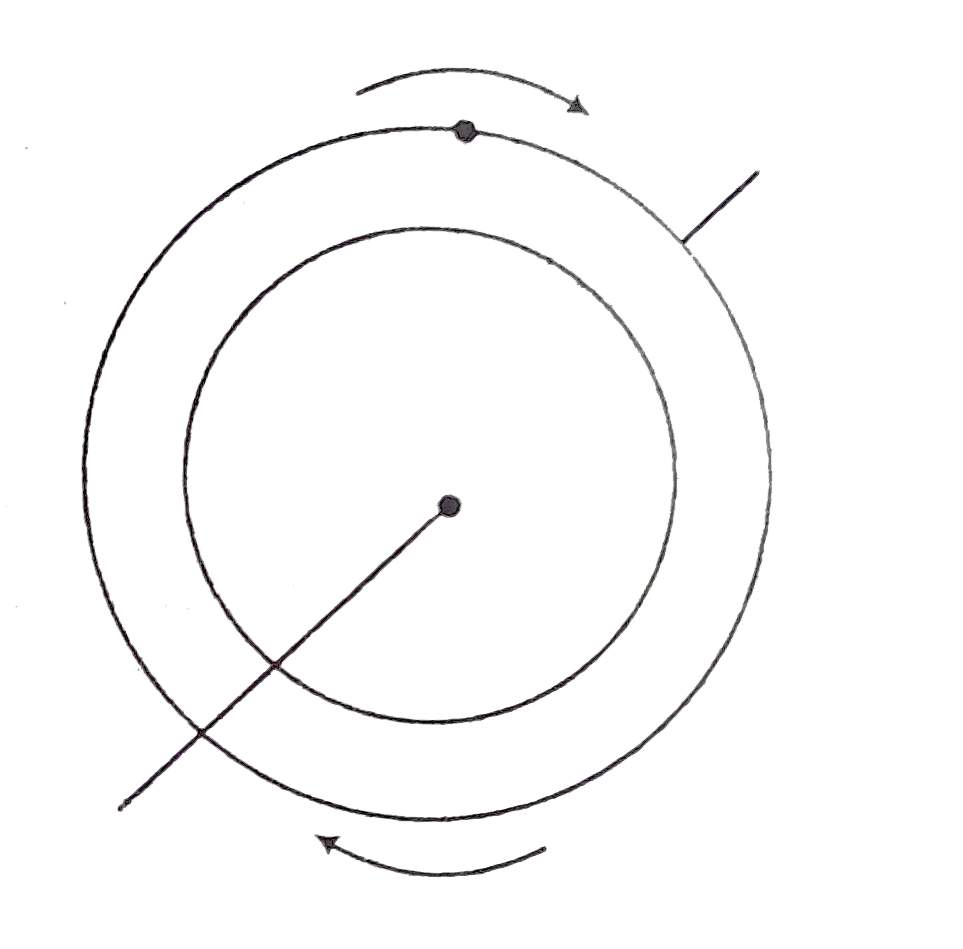A disc is made to oscillate about a horizontal axis passing through mid point of its radius. Determine time period.
To determine the time period of a disc oscillating about a horizontal axis passing through the midpoint of its radius, we can follow these steps:
Step 1: Identify the relevant parameters
- Let the radius of the disc be R.
- The mass of the disc is M.
- The distance from the center of mass to the axis of rotation (hinge point) is L=R2.
Step 2: Calculate the moment of inertia
Using the parallel axis theorem, the moment of inertia I about the hinge point can be calculated as:
I=Icm+Md2
where:
- Icm is the moment of inertia about the center of mass.
- d is the distance from the center of mass to the axis of rotation.
For a disc, the moment of inertia about its center is:
Icm=12MR2
The distance d from the center of mass to the hinge point is R2. Thus:
d=R2
Now substituting into the parallel axis theorem:
I=12MR2+M(R2)2
Calculating M(R2)2:
M(R2)2=M⋅R24=MR24
Therefore:
I=12MR2+MR24=2MR24+MR24=3MR24
Step 3: Apply the formula for the time period
The formula for the time period T of oscillation is given by:
T=2π√IMgL
Substituting the values we have:
- I=3MR24
- g is the acceleration due to gravity.
- L=R2
Now substituting these into the formula:
T=2π
⎷3MR24Mg⋅R2
This simplifies to:
T=2π
⎷3R24g⋅R2
=2π√3R24⋅2gR=2π√3R2g
Final Answer
Thus, the time period T of the oscillation is:
T=2π√3R2g
- Let the radius of the disc be R.
- The mass of the disc is M.
- The distance from the center of mass to the axis of rotation (hinge point) is L=R2.
Using the parallel axis theorem, the moment of inertia I about the hinge point can be calculated as:
I=Icm+Md2
where:
- Icm is the moment of inertia about the center of mass.
- d is the distance from the center of mass to the axis of rotation.
Icm=12MR2
The distance d from the center of mass to the hinge point is R2. Thus:
d=R2
Now substituting into the parallel axis theorem:
I=12MR2+M(R2)2
Calculating M(R2)2:
M(R2)2=M⋅R24=MR24
Therefore:
I=12MR2+MR24=2MR24+MR24=3MR24
The formula for the time period T of oscillation is given by:
T=2π√IMgL
Substituting the values we have:
- I=3MR24
- g is the acceleration due to gravity.
- L=R2
T=2π
⎷3MR24Mg⋅R2
This simplifies to:
T=2π
⎷3R24g⋅R2
=2π√3R24⋅2gR=2π√3R2g
Thus, the time period T of the oscillation is:
T=2π√3R2g
Topper's Solved these Questions
- BOOK - MOTIONCHAPTER - SIMPLE HARMONIC MOTIONEXERCISE - EXERCISE (Questions For Practice)22videos
SIMPLE HARMONIC MOTION
- BOOK - MOTIONCHAPTER - SIMPLE HARMONIC MOTIONEXERCISE - EXERCISE -1 (Objective Problems | NEET) SECTION-A BASIC TERMS AND DEFINITION OF S.H.M9videos
SIMPLE HARMONIC MOTION
- BOOK - MOTIONCHAPTER - SEMI CONDUCTOR AND LOGIC GATESEXERCISE - EXERCISE 334videos
SEMI CONDUCTOR AND LOGIC GATES
- BOOK - MOTIONCHAPTER - SIMPLE HARONIC MOTION EXERCISE - EXERCISE -4 (Leve-II) [ JEE 2011]11videos
SIMPLE HARONIC MOTION
Similar Questions
Knowledge Check
- Question 1 - Select One
A solid cube of side l is made to oscillate about a horizontal axis passing through one of its edges. Its time period will be
A2π√2√23lgB2π√23lgC2π√√32lgD2π√2√3lg - Question 2 - Select One
A disc is made to oscillate about a horizontal axis passing through mid point of its radius. Determine time period.
A2π√3R2gB2π√2R3gC2π√RgD2π√2Rg - Question 3 - Select One
A rod with rectangular cross section oscillates about a horizontal axis passing through one of its ends and it behaves like a seconds pendulum, its length will be
A1.5mB1mC3mD2m
A thin uniform rod of lenth 120cm is made to oscillate about an axis passing through it end. Find the period and other points about which it has the same time period (g=9.8ms−2).
View SolutionA disc is free to rotate about a smooth horizontal axis passing through its centre of mass. A particle is fixed at the top of the disc. A slight push is given to the disc and it starts rotating. During the process.
 View Solution
View SolutionIf a cone is cut into two parts by a horizontal plane passing through the mid point of its axis , the ratio of the volumes of the upper part and the frustum is :
View SolutionIf a cone is cut into two parts by a horizontal plane passing through the mid point of its axis , the ratio of the volumes of the upper part and the frustum is :
View SolutionIf a cone is cut into two parts by a horizontal plane passing through the mid-point of its axis, then the ratio of the volumes of the upper part and the given cone is
View Solution

